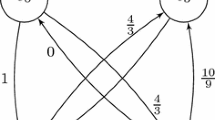Abstract
We show how to use polynomial and strongly polynomial capacity scaling algorithms for the transshipment problem to design a polynomial dual network simplex pivot rule. Our best pivoting strategy leads to an O(m 2 logn) bound on the number of pivots, wheren andm denotes the number of nodes and arcs in the input network. If the demands are integral and at mostB, we also give an O(m(m+n logn) min(lognB, m logn))-time implementation of a strategy that requires somewhat more pivots.
Similar content being viewed by others
References
R.K. Ahuja, T.L. Magnanti and J.B. Orlin, “Network flows,” in: G.L. Nemhauser, A.H.G. Rinnooy Kan and M.J. Todd, eds.,Handbook of Operations Research and Management Science, Vol. 1: Optimization (Elsevier, Amsterdam, 1989) pp. 211–369.
M.L. Balinski, “Signature methods for the assignment problem,”Operations Research 33 (1985) 527–536.
W.H. Cunningham, “Theoretical properties of the network simplex method,”Mathematics of Operations Research 4 (1979) 196–208.
R. Dial, F. Glover, D. Karney and D. Klingman, “A computational analysis of alternative algorithms and labelling techniques for finding shortest path trees,”Networks 9 (1979) 215–248.
L.R. Ford, Jr. and D.R. Fulkerson,Flows in Networks (Princeton University Press, Princeton, NJ, 1962).
A.V. Goldberg, M.D. Grigoriadis and R.E. Tarjan, “Use of dynamic trees in a network simplex algorithm for the maximum flow problem,”Mathematical Programming 50 (1991) 277–290.
A.V. Goldberg, É. Tardos and R.E. Tarjan, “Network flow algorithms,” in: B. Korte, L. Lovász, H.J. Proemel and A. Schrijver, eds.,Paths, Flows and VLSI-Design (Springer, Berlin, 1990) pp. 101–164.
D. Goldfarb and J. Hao, “A primal simplex algorithm that solves the maximum flow problem in at mostnm pivots and O(n 2 m) time,”Mathematical Programming 47 (1990) 353–365.
J.B. Orlin, “Genuinely polynomial simplex and non-simplex algorithms for the minimum cost flow problem,” Technical Report No. 1615-84, Sloan School of Management, MIT (Cambridge, MA, 1984).
J.B. Orlin, “On the simplex algorithm for networks and generalized networks,”Mathematical Programming Studies 24 (1985) 166–178.
J.B. Orlin, “A faster strongly polynomial minimum cost flow algorithm,” to appear in:Operations Research. [Preliminary version appeared in theProceedings of the 20th ACM Symposium on Theory of Computing.]
S. Plotkin and É. Tardos, “Improved dual network simplex,” in:Proceedings of the 1st ACM-SIAM Symposium on Discrete Algorithms (1990) pp. 367–376.
R.E. Tarjan, “Efficiency of the primal network simplex algorithm for the minimum-cost circulation problem,”Mathematics of Operations Research 16 (1991) 272–291.
Author information
Authors and Affiliations
Additional information
Research supported by AFOSR-88-0088 through the Air Force Office of Scientific Research, by NSF grant DOM-8921835 and by grants from Prime Computer Corporation and UPS.
Research supported by NSF Research Initiation Award CCR-900-8226, by U.S. Army Research Office Grant DAAL-03-91-G-0102, and by ONR Contract N00014-88-K-0166.
Research supported in part by a Packard Fellowship, an NSF PYI award, a Sloan Fellowship, and by the National Science Foundation, the Air Force Office of Scientific Research, and the Office of Naval Research, through NSF grant DMS-8920550.
Rights and permissions
About this article
Cite this article
Orlin, J.B., Plotkin, S.A. & Tardos, É. Polynomial dual network simplex algorithms. Mathematical Programming 60, 255–276 (1993). https://doi.org/10.1007/BF01580615
Received:
Revised:
Issue Date:
DOI: https://doi.org/10.1007/BF01580615




